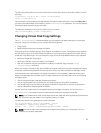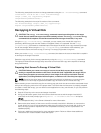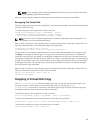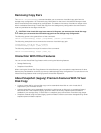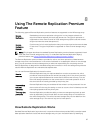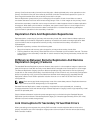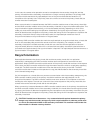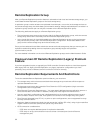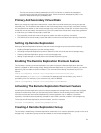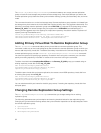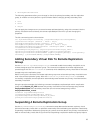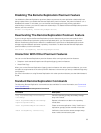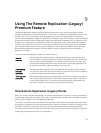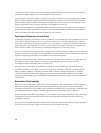
– The first port that successfully establishes an iSCSI connection is used for all subsequent
communication with that remote storage array. If that connection subsequently fails, a new
session is attempted using any available ports.
Primary And Secondary Virtual Disks
Before you create any replication relationships, virtual disks must exist at both the primary site and the
secondary site. The virtual disk that resides on the local storage array is the primary virtual disk. Similarly,
the virtual disk that resides on the remote storage array is the secondary virtual disk. If neither the primary
virtual disk nor the secondary virtual disk exist, you must create these virtual disks. Keep these guidelines
in mind when you create the secondary virtual disk:
• The secondary virtual disk must be of equal or greater size than the primary virtual disk.
• The RAID level of the secondary virtual disk does not have to be the same as the primary virtual disk.
Setting Up Remote Replication
Setting up Remote Replication between local and remote storage arrays consists of the following:
• Enabling Remote Replication (on both storage arrays)
• Activating the Remote Replication premium feature on both the local and remote storage arrays.
• Creating a Remote Replication group on the local storage array.
• Adding a replicated pair of virtual disks to the Remote Replication group.
Enabling The Remote Replication Premium Feature
The first step in creating a remote replication is to make sure that the Remote Replication premium
feature is enabled on both storage arrays. Because Remote Replication is a premium feature, you need a
feature key file to enable the premium feature. The command for enabling the feature key file is as
follows:
enable storageArray feature file=”asyncReplicationactivation_key”
In this command, asyncReplication is literal and is appended with the activation_key, which is
provided by Dell. For example, if your activation key value is 999999:
enable storageArray feature file="asyncReplication999999"
Activating The Remote Replication Premium Feature
Activating the Remote Replication premium feature prepares the storage arrays to create and configure
replication relationships. After you activate the premium feature, the secondary ports for each RAID
controller module are reserved and dedicated to remote replication use. In addition, replication
repository virtual disks are automatically created for each RAID controller module in the storage array.
To activate the Remote Replication premium feature, use this command:
activate storageArray feature=asyncReplication
Creating A Remote Replication Group
The first step in establishing a Remote Replication relationship is to create a replication group on the local
storage array. A replication group cannot be created on the remote storage array.
91



